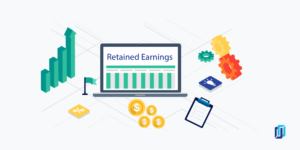
Businesses want to make money. What they do with the money they make says a lot about their future intentions. Monitoring a business’ retained earnings balance is a way to see inside their plans for the future and know if the business is getting ready to expand. Investors can tell a lot about a company based on its retained earnings balance.
Since retained earnings are so important to investors, let’s look at what they are, how they’re calculated, and what you can learn from them.
What are retained earnings?
Retained earnings are the portion of net income that remains after a company makes dividend payments to their stockholders. It represents the balance of the profits that can be used to invest in the company, expand services, or pay off debt. The balance carries over each period and can be calculated on a quarterly or annual basis.
Net income is calculated by subtracting cost of goods sold (COGS), business expenses, and taxes from the revenue earned during a certain time period. A breakdown of this calculation is shown on a company’s income statement. If cash dividends or stock dividends are paid to stockholders, the value of those dividends is subtracted from net income and the result is retained earnings. Retained earnings are shown on a company’s balance sheet as part of the equity section.
How are retained earnings calculated?
The retained earnings formula is as follows:
Retained Earnings Balance = Beginning RE + net income/loss – dividends
To calculate the retained earnings balance for the first quarter, start with the retained earnings balance from the end of the year and add the net income or loss for the first quarter, then subtract any dividends paid at the end of the quarter. The answer is the new retained earnings balance.
For example, say the retained earnings balance at the end of the year was $100,000. Net income for the first quarter was $20,000. Dividends of $2,000 were paid out. The retained earnings balance would be $118,000.
$100,000 + $20,000 – $2,000 = $118,000
Retained earnings can be a negative amount if the net loss for a period was high or the company paid out a bunch of dividends. This isn’t necessarily a bad thing, as it may be that management made a business decision to share the profits with their stockholders instead of hanging onto them.
What can retained earnings be used for?
Retained earnings can be used to purchase assets, expand the workforce, or pay loans or debt. All of these are ways of investing in the business.
Purchasing assets could lead to more production or business expansion, and adding to the workforce can lead to more income. Paying down loans or debt reduces future interest expense, which is an investment as well. Retained earnings can also be returned to stockholders in the forms of dividends, which can be in cash or additional stock.
Statement of retained earnings
Large companies often publish a separate financial statement called the “statement of retained earnings” or “retained earnings statement.” It reconciles the beginning and ending retained earnings balances for the period, showing details of the calculation such as net income and dividends paid during the period.
Here’s a sample statement of shareholder equity showing retained earnings that you can use for reference.
What do retained earnings tell you about a business?
Generally speaking, companies with higher amounts of retained earnings are holding their profits to reinvest in the company. They may be planning to expand the business or make a large asset purchase, such as a building. Stockholders may or may not appreciate management holding on to the profits, as many investors are interested in receiving dividends of some kind for their investments.
Net income has a direct effect on the retained earnings balance shown on the balance sheet, so if a company has been losing money it will show up as a reduction in retained earnings. Investors should watch this carefully to ensure that the business gets back on track or has plans to get through the slow period.
Investors often look at the retention ratio, which can be determined by reviewing the statement of retained earnings. The retention ratio represents the percentage of net income that is held by the company in retained earnings and not spent in dividends or other purchases.
If a company has a low retention ratio and spends all its net income as dividends, the potential for future profit may suffer. Most investors are looking for a balance between dividends and reinvestment.
Another ratio that investors will look at is the payout ratio. It represents the percentage of net income that is paid out as dividends to stockholders. Investors looking for regular returns will want a higher payout ratio to ensure that they receive money on a regular basis.
Retained earnings equal growth
Retained earnings are the portion of net income that remains after a company’s shareholders are paid dividends. It’s a form of shareholder equity and can be used to purchase assets, expand the business, or pay off debt.
Business owners and shareholders watch the retained earnings balance carefully, as it is directly affected by net income and can show a company’s commitment to future growth.
